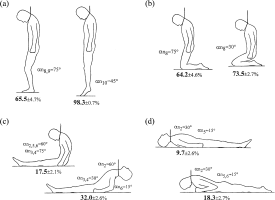Is Partial Hanging reliable? What are the chances I might fail, and how would those happen?
I think it can be reliable, with some caveats.
Based on my understanding, there are two potential problems with partial suspension: 1) doing it in a position where there isn't enough pressure; 2) not being able to commit, or backing out within the first few seconds.
Body position and pressure on the neck
I have seen comments where people say they've successfully passed out, then magically woke up, even after several minutes. This is just an educated opinion, but I believe this only happens when it's done in a sitting or lying position, where there isn't enough tension in the first place.
See the image below, which is from a study (
link 1,
link 2). It shows the tension on the rope in various positions as the percentage of body weight. It's clear why sitting and lying are so bad — there isn't enough tension. Even kneeling is dangerous if the knees are sharply bent (image, part b, right side), because it can easily turn into a sitting position.
I believe partial can be reliable if done standing (image, part a) or kneeling upright with the knees only slightly bent (image, part b, left side). Standing is probably the safest, because there is a lot of room for error in terms of height.
There is still a chance — even in a sitting or high kneeling position — that involuntary body movements cause the body to shift in a way that eases pressure on the neck, but I think this chance is quite low. I mean, if about 2/3 of the body weight or more is on the rope, that's
a lot of pressure to be removed by chance alone.
 Ability to commit and backing out
Ability to commit and backing out
The other problem with partial is that some people can't lean into the noose with enough pressure. They try and try again, get the exploding head feeling, but are unable to apply enough pressure to block the carotid arteries. With full suspension, this is not an issue.
Or some people can actually apply enough pressure, but they back out immediately as they start to pass out, before fully losing consciousness. This is not necessarily something we can control. SI can be really strong. Again, this is not an issue with full suspension.
Reasons for doing partial
I think people often choose partial for the wrong reasons. Some people think that by doing partial, they can completely avoid all pain and discomfort. They try to do it in a sitting position, because that puts less pressure on the neck, and they think it's a good way to avoid pain — but it just leads to failure. Or they try to ease into the noose too carefully, but again, they just fail because they never manage to pass out.
I believe the painless nature of hanging (partial or full) comes from the fact that it's quick. We can't expect to feel nothing at all within the first few seconds. If someone is willing to accept that initial discomfort, hanging is extremely effective. If not, they'll never get it right, no matter how much time they spend perfecting their setup.
The ideal method would be comfortable
and accessible
and effective. But such a method doesn't exist. There is always a trade-off. We can choose two out of those three, based on what's most important to us. Having all three together is impossible.



